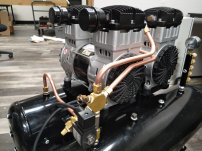Jraef
Titanium
- Joined
- Aug 10, 2004
- Location
- San Francisco Bay Area
If you like watching paint dry, I have a youtube video where I reform the caps in a VFD using the variac method
The VFD will most likely turn on around 60% rated voltage with an undervoltage error.
I've found most VFD's will run on single phase, even higher (600v) ones, as JST said you may need to set a parameter to ignore the input phase fault.
The fault is irrelevant in this case, you are not wanting to run the motor while reforming. You are still reforming the caps even if the drive is faulted.


